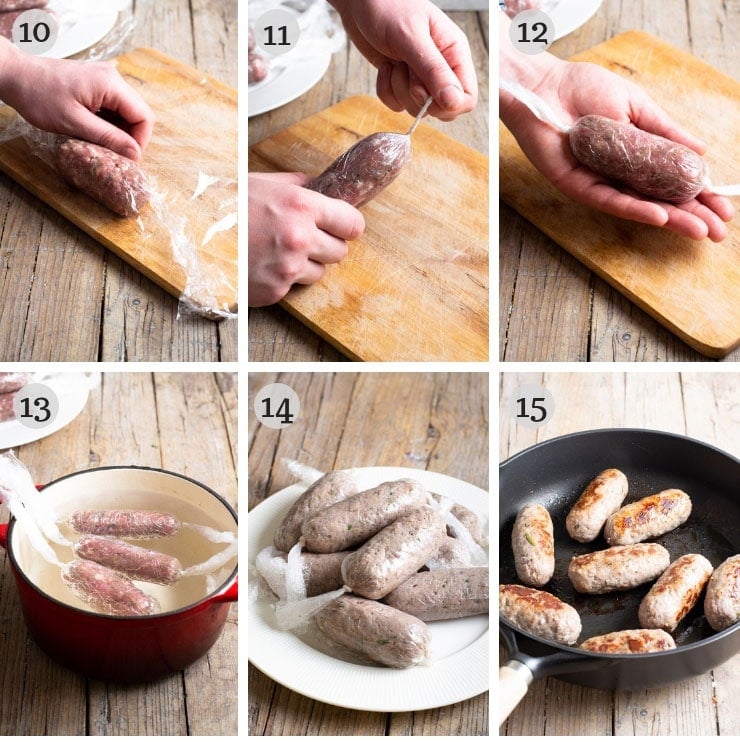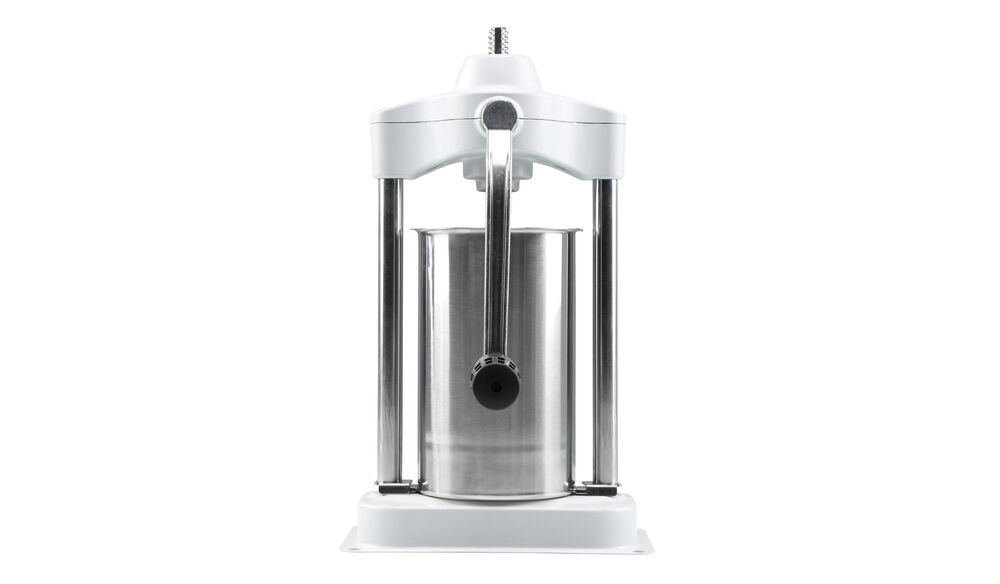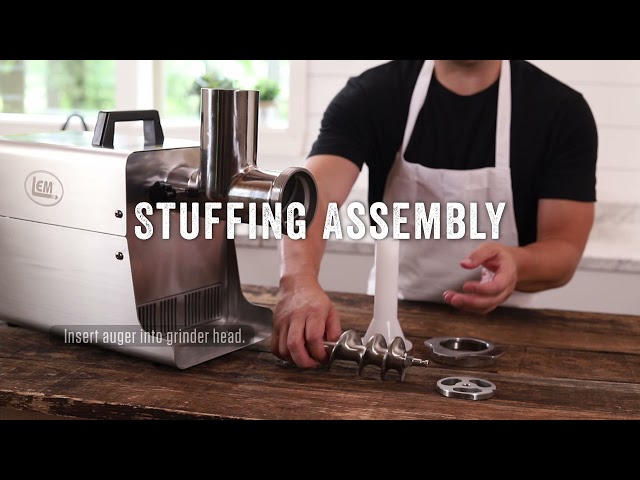To stuff sausage casings without a machine, simply hold the tied end of the casing in one hand and guide the meat mixture with the other hand as it fills the casing. This technique allows for a homemade sausage without any special equipment.
In addition, there are various tips and tricks to ensure success in stuffing sausage casings by hand, such as adjusting seasoning, twisting into links, fixing holes, and air drying before cooking. With some practice and patience, anyone can make delicious sausages at home without the need for a machine.
So why not give it a try and impress your friends and family with your homemade sausage-making skills?
Introduction To Hand-stuffed Sausages
Discover the art of hand-stuffed sausages with our simple guide to stuffing sausage casings without a machine. Learn the step-by-step technique for filling casings by hand, ensuring delicious homemade sausages every time. Master the process and create your own unique sausage flavors with ease.
Benefits Of Manual Sausage Stuffing
When it comes to hand-stuffed sausages, there are several benefits to consider. First, manual sausage stuffing allows for better control over the stuffing process, ensuring that the casings are evenly filled without overstuffing. Second, it gives you the flexibility to experiment with different flavors and textures, as you can easily adjust the filling as you go. Lastly, manual stuffing is a more accessible option for those who don’t have a dedicated sausage stuffer, allowing anyone to enjoy the process of making homemade sausages.
What You’ll Need
Before you begin the process of hand-stuffing sausages, it’s important to gather the necessary tools and ingredients. Here’s a quick rundown of what you’ll need:
- Fresh sausage casings
- Ground meat of your choice
- Seasonings and spices
- A large bowl for mixing the sausage filling
- A sausage pricker or toothpick to remove air pockets
- A sharp knife for cutting and linking the sausages
- A sausage tying tool or kitchen twine
- A clean work surface for stuffing and linking
Choosing The Right Casings
When it comes to stuffing sausage casings without a machine, choosing the right casings is crucial. The type of casing you select will impact the texture and flavor of your sausage. Additionally, properly preparing the casings for stuffing is essential to ensure a smooth and efficient stuffing process.
Types Of Sausage Casings
Before diving into the stuffing process, it’s important to understand the different types of sausage casings available. The main types of casings include:
- Natural Casings: Derived from animal intestines, such as hog, sheep, or beef, natural casings provide a traditional and authentic touch to sausages. They are known for their superior flavor and texture.
- Collagen Casings: These casings are made from collagen derived from animal hides and are uniform in size. They are ideal for uniform sausages and are easy to work with.
- Fibrous Casings: Made from cellulose, these casings are non-edible and are often used for larger sausages like salamis and summer sausages. They provide a consistent diameter and are easy to peel off after cooking.
Preparing Casings For Stuffing
Properly preparing the casings before stuffing is essential to ensure a successful sausage-making process. Here are the steps to prepare casings for stuffing:
- Soaking: If you’re using natural casings, soak them in lukewarm water for at least 30 minutes to remove excess salt and soften them for easy handling.
- Rinsing: After soaking, rinse the casings thoroughly under cold water to remove any remaining salt or debris.
- Checking for Holes: Carefully inspect the casings for any holes or tears. Gently run water through them to check for leaks and ensure they are intact before stuffing.
- Storage: If you have leftover casings, store them in a salt solution or in the refrigerator according to the manufacturer’s instructions to keep them fresh for future use.
Creating The Sausage Mixture
To create the sausage mixture without a machine, simply place the seasoned meat in a piping bag or a plastic food storage bag. Next, carefully guide the meat into the sausage casing using your hands, ensuring an even distribution. Rotate and twist the casings to form individual sausages, and voila!
Selecting The Best Meats And Spices
When it comes to creating the perfect sausage mixture, selecting the best meats and spices is crucial. The quality and flavor of your sausages will greatly depend on the ingredients you choose. Here are some tips for selecting the best meats and spices for your homemade sausages:- Choose high-quality cuts of meat, such as pork shoulder or beef chuck, that have a good balance of fat and lean meat.
- Opt for fresh and organic meats whenever possible to ensure the best flavor and texture.
- Experiment with different types of meats, such as lamb or chicken, to create unique flavor profiles.
- When it comes to spices, start with the basics like salt, pepper, garlic powder, and paprika.
- Feel free to get creative with your spice combinations by adding herbs like sage, thyme, or rosemary, as well as other flavors like fennel seeds, chili flakes, or smoked paprika.
- Consider the flavor profile you want to achieve and adjust the spices accordingly. Remember that a little goes a long way, so start with small amounts and taste as you go.
Mixing Your Ingredients
Now that you have selected the best meats and spices for your sausage mixture, it’s time to start mixing everything together. Follow these steps to ensure a well-blended and flavorful sausage mixture:- Begin by cutting the meat into small chunks to make it easier to handle and grind.
- Next, combine the meat with the selected spices and any additional ingredients you may be using, such as minced garlic or diced onions.
- If you have a meat grinder, pass the meat mixture through the grinder using the appropriate disc for the desired texture. Alternatively, you can use a food processor to finely chop the meat.
- Once the meat is ground or chopped, transfer it to a large mixing bowl and use your hands to thoroughly mix the ingredients together. This will help distribute the spices evenly throughout the mixture.
- Make sure to mix the ingredients until they are well combined and the spices are evenly distributed. This will ensure consistent flavor in every bite.
Filling The Casings By Hand
Stuffing sausage casings by hand is a simple process that doesn’t require a machine. As you fill the casing with the meat mixture, hold the tied end in one hand and guide the meat with the other. This method allows you to make homemade sausages without the need for special equipment.
Techniques For Stuffing Without Tools
When it comes to filling sausage casings by hand, there are a few techniques you can use to ensure a successful and even filling. These methods are especially useful if you don’t have access to a sausage stuffing machine. Let’s explore some of these techniques:
1. The Spoon Method
One simple and effective technique is the spoon method. To use this method, you will need a spoon with a long handle and a smooth surface. Start by scooping a small amount of the sausage mixture onto the spoon. Then, using your other hand, gently push the mixture into the casing, making sure to keep it compact. Repeat this process until the casing is filled.
2. The Pastry Bag Method
If you have a pastry bag or a plastic food storage bag, you can use it to fill the sausage casings. Fill the bag with the sausage mixture, then cut a small opening at one corner of the bag. Squeeze the mixture into the casing, guiding it along with your other hand. This method allows for more control and precision when filling the casings.
3. The Hand-scooping Method
Another technique is the hand-scooping method. With this method, you scoop a small amount of the sausage mixture into the palm of your hand. Then, using your other hand, gently push the mixture into the casing, ensuring an even distribution. This method requires a bit more dexterity and practice, but it can be quite effective.
Ensuring Even Filling
Regardless of the technique you choose, it’s important to ensure even filling throughout the casing. This will help prevent air pockets and ensure that the sausage cooks evenly. Here are some tips to ensure even filling:
- Take your time and work slowly to avoid overfilling or underfilling the casings.
- Use your fingers to gently distribute the mixture, making sure there are no gaps or air pockets.
- Twist the casings at regular intervals to create individual sausages.
- If you notice any holes or gaps in the casing, use your fingers to gently pinch and seal them.
By following these techniques and tips, you can successfully fill sausage casings by hand, even without a machine. So go ahead and give it a try!
Twisting And Linking Sausages
Learn the art of stuffing and linking sausages without a machine by following these simple steps. As the meat fills the casing, hold the tied end and guide the meat mixture with your other hand. After filling, twist the sausages into links for a homemade touch.
Twisting and Linking Sausages Twisting and linking sausages is a crucial step in the process of making homemade sausages without a machine. It may seem daunting at first, but with a little practice and patience, you can perfect this technique and create perfectly formed and delicious sausages. Step-by-step guide to linking Here is a step-by-step guide to linking sausages by hand: 1. Once you have filled the casing with the sausage mixture, tie a knot at the end of the casing to close it off. 2. Hold the sausage casing with one hand and use the other hand to twist a section of the sausage casing to form the first link. Make sure the link is tight enough to prevent the sausage from unraveling, but not so tight that it bursts. 3. Twist the next section of the casing in the opposite direction, creating another link. Repeat this process until you reach the end of the casing. 4. Once you have formed all the links, tie a knot at the end of the casing to close it off. Tips to prevent unraveling To prevent the sausages from unraveling, here are some tips to follow: – Make sure the sausage mixture is not too loose, as this can cause the casing to burst. – Don’t twist the links too tightly, as this can also cause the casing to burst. – Use a sharp knife to cut the sausages, as a dull knife can tear the casing. – Let the sausages dry for at least an hour before cooking, as this will help the casing to set and prevent unraveling. – Store the sausages in the refrigerator or freezer until ready to use. In conclusion, twisting and linking sausages by hand is a simple and easy way to make delicious homemade sausages without the need for a machine. With a little practice, you can master this technique and create perfectly formed sausages that are sure to impress your family and friends.
Credit: thecookful.com
Dealing With Common Issues
Stuffing sausage casings without a machine can be a daunting task, but it is possible with a few simple steps. Firstly, hold the tied end of the casing in one hand and use the other hand to guide the meat mixture as it fills the casing.
Then twist the sausage into links and let it air dry for at least an hour before wrapping the meat.
Dealing with Common Issues Stuffing sausage casings by hand can be a challenging task, especially if you’re doing it for the first time. There are a few common issues that you may encounter while stuffing sausage casings without a machine. In this section, we’ll discuss some tips and tricks to deal with these common issues. Fixing tears and holes One of the most common issues you may face while stuffing sausage casings by hand is tears or holes in the casing. If you notice a tear or a hole in the casing, don’t panic! You can fix it easily. Here’s what you need to do: 1. Stop stuffing the casing immediately. 2. Pinch the casing together at the tear or hole to close it. 3. Tie a knot at the end of the casing to prevent the filling from coming out. 4. Use a sterilized needle to make a small hole near the tear or hole. 5. Gently push the filling into the hole until it reaches the other side of the tear or hole. 6. Pinch the casing together again to close the tear or hole. 7. Continue stuffing the casing as usual. Managing air pockets Another common issue while stuffing sausage casings by hand is air pockets. Air pockets can cause the sausage to burst while cooking, which is not ideal. Here are some tips to manage air pockets: 1. Make sure that the filling is evenly distributed in the casing. 2. Use a sterilized needle to prick the casing in several places to release any trapped air. 3. Gently massage the sausage to distribute the filling and remove any air pockets. 4. If you notice a large air pocket, use a sterilized needle to make a small hole near it, and gently push the filling into the hole until the air is released. Ensuring each H3 heading adheres to HTML syntax, here are the headings in HTML format:Fixing Tears And Holes
Managing Air Pockets
Drying And Storing Your Sausages
Stuffing sausage casings without a machine can be done by hand, but it requires some patience and practice. To start, hold the tied end of the casing in one hand, while guiding the meat mixture with the other. Once the casing is filled, twist it into links and let it air dry for at least an hour before wrapping.
Ideal Conditions For Drying
Properly drying your sausages is crucial to achieve the desired texture and flavor. Here are the ideal conditions for drying your sausages:
- Temperature: Maintain a consistent temperature of around 55-60°F (12-15°C) in a well-ventilated area. Avoid direct sunlight or high heat, as it can cause the sausages to spoil or develop off flavors.
- Humidity: Aim for a humidity level of around 70-80%. This helps prevent the sausages from drying too quickly, which can result in a tough exterior. You can use a hygrometer to monitor the humidity levels.
- Air Circulation: Good air circulation is essential to prevent the growth of mold and ensure even drying. Place the sausages on drying racks or hang them with enough space between each sausage to allow for proper airflow.
By following these ideal conditions, you can achieve perfectly dried sausages with a balanced texture and flavor.
Storage Best Practices
Once your sausages are dried, it’s important to store them properly to maintain their quality and extend their shelf life. Here are some storage best practices to keep in mind:
- Wrap individually: Wrap each dried sausage individually in butcher paper or wax paper. This helps prevent them from sticking together and allows for easy portioning.
- Store in a cool, dry place: Find a cool and dry area, such as a pantry or cellar, to store your sausages. Avoid storing them in areas with high humidity or fluctuating temperatures.
- Avoid direct sunlight: Sunlight can cause the sausages to spoil and develop off flavors. Keep them away from direct sunlight by storing them in a dark area.
- Use airtight containers: If you prefer to store your sausages in containers, make sure they are airtight to prevent moisture and air from entering. Mason jars or vacuum-sealed bags work well for this purpose.
- Label and date: To keep track of the freshness, label each package with the type of sausage and the date it was made. This helps you use them in a timely manner and ensures you don’t consume expired sausages.
By following these storage best practices, you can enjoy your homemade sausages for an extended period, maintaining their quality and flavor.

Credit: m.youtube.com
Cooking And Enjoying Your Homemade Sausages
Discover the joy of crafting and savoring your own homemade sausages without the need for a machine. Simply guide the meat mixture into the casing by hand, then twist the links for a delightful culinary experience.
Cooking Techniques For Best Flavor
When it comes to cooking your homemade sausages, there are a few techniques you can use to ensure the best flavor. Here are some tips to help you achieve delicious results: 1. Grilling: Grilling your sausages can give them a smoky and charred flavor that many people love. Preheat your grill to medium heat and cook the sausages for about 10-12 minutes, turning them occasionally to ensure even cooking. 2. Pan-Frying: Pan-frying is another popular cooking method for sausages. Heat a little oil in a skillet over medium heat and add the sausages. Cook them for about 8-10 minutes, turning them frequently until they are golden brown and cooked through. 3. Baking: Baking your sausages is a convenient option that requires less attention. Preheat your oven to 375°F (190°C) and place the sausages on a baking sheet lined with parchment paper. Bake them for about 20-25 minutes, or until they are cooked through and have reached an internal temperature of 160°F (71°C). 4. Boiling: Boiling sausages is a quick and easy method that can help retain their juiciness. Fill a pot with enough water to cover the sausages and bring it to a boil. Add the sausages and let them cook for about 10-12 minutes, or until they are fully cooked.Serving Suggestions
Now that your homemade sausages are cooked to perfection, it’s time to enjoy them. Here are some serving suggestions to enhance your sausage experience: – Serve them on a bun: Place your sausages in a soft, toasted bun and top them with your favorite condiments such as mustard, ketchup, sauerkraut, or grilled onions. – Add them to pasta dishes: Slice your sausages and toss them into pasta dishes like spaghetti or penne for a hearty and flavorful meal. – Pair them with sautéed vegetables: Sauté some bell peppers, onions, and mushrooms, and serve them alongside your sausages for a delicious and colorful combination. – Make a sausage platter: Arrange a variety of cooked sausages on a platter and serve them with an assortment of mustards, pickles, and cheeses for a tasty and customizable spread. – Serve with mashed potatoes: Slice your sausages and serve them with creamy mashed potatoes for a comforting and satisfying meal. Remember, the possibilities are endless when it comes to serving your homemade sausages. Get creative and experiment with different flavors and accompaniments to find your perfect combination. Enjoy!
Credit: www.insidetherustickitchen.com
Frequently Asked Questions
Can You Stuff Sausage Casings By Hand?
Yes, you can stuff sausage casings by hand. Hold the tied end of the casing in one hand and guide the meat mixture as it fills the casing. This allows you to control the process without the need for a machine.
How To Stuff Sausage Without A Machine?
To stuff sausage without a machine, hold the casing with one hand and guide the meat with the other as it fills the casing.
How To Stuff Sausages At Home?
To stuff sausages at home, simply fill the casing with meat mixture by hand. Hold the casing with one hand and guide the meat with the other. Twist into links, fix any holes, and let it air dry. No machine needed!
Conclusion
Stuffing sausage casings without a machine is doable and satisfying. With the right technique and a bit of practice, you can achieve excellent results. Whether you’re making Italian sausages or breakfast links, the process is manageable and enjoyable. Get creative and enjoy making your own delicious sausages at home!




